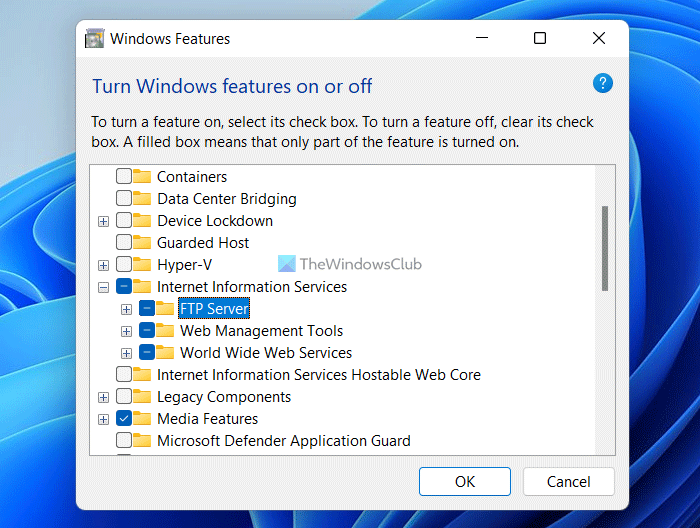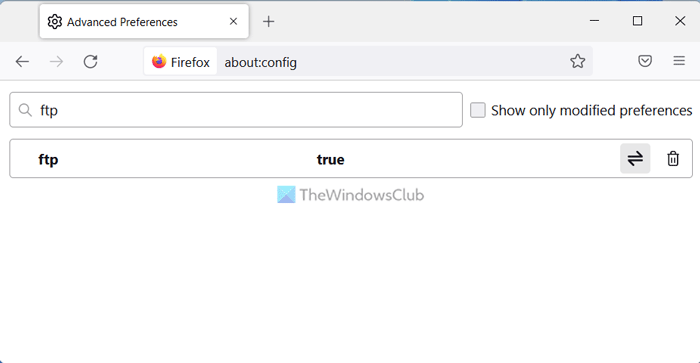If FTP is not working in your Chrome, Firefox or Edge browser on Windows PC, and you are looking for resolution, then you have come to the right place. We decided to write this post since we received emails asking us why FTP was not working in their browser. You should know that the option to enable or disable the FTP setting has been deprecated in the Google Chrome browser a long time back. It will be a waste of time if you are trying to find it in the browser. Nevertheless, if you are using an earlier version or some other browser, then you may try the following suggestions to resolve the FTP not working in the browser issue.
FTP not working in Chrome, Firefox or Edge browser
If FTP is not working in your browser, follow these steps:
- Know the credentials
- Enable FTP in Windows Features
- Check FTP settings in Firefox browser
To learn more about these steps, continue reading.
1] Know the credentials
To use an FTP server, you need to know the credentials of that server. Without knowing the username and password, you may not be able to access the FTP server in the browser. No matter whether you use Google Chrome, Mozilla Firefox, or Microsoft Edge, you cannot get into the server without knowing the credentials.
However, it doesn’t apply when you are trying to access a public FTP server. There are some companies that offer their downloads via FTP server to the public. In such cases, you may not need to know the username and password.
2] Enable FTP in Windows Features

In order to use the FTP in the browser, you need to enable three things – FTP Server, Web Management Tools, and World Wide Web Services. All of these three are optional features, and they are not enabled by default. Whether you use Windows 11, Windows 10, or any other version of Windows, you need to turn them on manually.
Without enabling these three tools, you won’t be able to use FTP in the browser. Whether it is your personal FTP server or public FTP, you need to enable these three features. For your information, you do not need to download third-party software. Instead, you can use the Windows Features panel to get the job done.
To enable FTP in Windows 11/10, follow these steps:
- Search for windows features in the Taskbar search box.
- Click on the individual search result.
- Tick the Internet Information Services checkbox.
- Make sure all three checkboxes are ticked.
- Click the OK button.
- Restart your computer.
After that, check if you can access FTP in the browser or not.
3] Check FTP settings in Firefox browser

Although Google Chrome and Microsoft Edge do not offer an option to enable or disable FTP in the browser, you can turn this setting on or off in the Firefox browser. Therefore, if you are using the Mozilla Firefox browser, follow these steps to enable FTP:
- Open the Firefox browser on your computer.
- Enter about:config in the address bar.
- Click the Accept the Risk and Continue button.
- Search for ftp.
- If the status is set to false, double-click on the value to set it true.
Then, restart your computer and check if it resolves the issue or not.
Read: How to access FTP Server using Notepad++
Why is FTP not working in Chrome?
From Google Chrome 81, the company has removed the FTP support for the Google Chrome browser. It is not possible to use Google Chrome as an FTP client. For that, you need to use a dedicated FTP client on your computer.
Read: Best Free FTP Client software for Windows PC
Why is FTP not working Firefox?
The FTP protocol is disabled by default in the latest version of the Mozilla Firefox browser. If you are using the latest version of this browser, you need to enable it manually. For that, open the Configuration panel and search for ftp. Then, double-click on it to set the value as true.
That’s all! Hope this guide helped.
Read: Cyberduck: Free FTP, SFTP, WebDAV, Google Drive client for Windows PC.
Leave a Reply